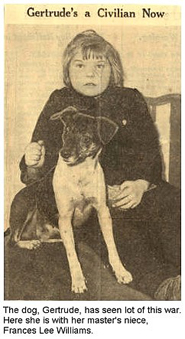Sub-Chaser Mascot Ends Her Travels
By Neal Ashby.
If there were a “Who’s Who for Dogs,” Gertrude would take up a lot of space. She’s been around.
Gertrude, a multi-colored mutt of a dog, has been to war. She did a tour of duty on a navy sub-chaser that lasted almost two and one-half years.
The sub-chaser, Gertrude aboard as a mascot, was in the invading convoys at North Africa, Sicily, Salerno and the Anzio beachhead.
Gertrude is a civilian now; she’s putting up with Mr. and Mrs. Bert Courtney at 505 N. E. Tenth st. She belongs, more or less, to their son, J. H., a navy signalman.
J. H. Was Given a Puppy
The dog’s story begins about the middle of March, 1942. J. H.’s sub-chaser was in port at Key West, Fla. One night, a taxi driver gave him a puppy, then nine inches long, with grew up to be Gertrude.
J. H. wanted to take Gertrude on board, but he knew the skipper would never allow it. He took her aboard, anyway. Gertrude stayed.
Gertrude concluded her voyage to North Africa, which began after her acceptance as a member of the sub-chaser’s crew, by bearing a litter of eight pups off the shore.
The puppies, carrying on with a newly-established family tradition, became the mascots of eight other ships lying at anchor nearby.
Gertrude slept at the foot of J. H.’s bunk. To this day she eats no raw meat, since in her stretch at sea, she ate nothing but the same cooked rations served to the crewmen.
The crewmen, also, are responsible for a sweet tooth she had: always wants candy and nuts.
Kept Prowlers Away.
At North Africa, Arabs sometimes seemed inclined to steal from the ships. Not J. H.’s ship. Gertrude kept them away.
The sailors taught her some simple tricks, with a ball and such, but nothing complicated, for Gertrude has too much effervescence for that.
Gertrude loves a bath. Aboard the sub-chaser, a weekly bath for Gertrude was a regular detail for the men.
In battle, J. H., as signalman, was the only man on deck of the sub-chaser.
Gertrude, with a keen nose for impending action, was scratching at his feet when shooting was in the offing. She remained topside as long as she could, before fright and bewilderment forced her to duck into the sound room with a woeful glance back at J. H.
J. H. and Gertrude came back to America in June. J. H. brought her by train as far as Hobart, Ind., where he was to pick up his bride-to-be. Gertrude was to be shipped on to Des Moines from there.
Escaped Railroad Men.
Somewhere in Indiana, Gertrude, with no friend at her side, got away from the railroad men and off the train. She hated civilians, having had scant contact with them in her young life, and no one could retrieve her.
Finally, a sailor was recruited. He represented a friend to Gertrude, and she obligingly permitted herself to be placed back inside her crate.
“She’s crazy for sailors,” J. H.’s mother was saying Wednesday night.
J. H. has been sent to Panama since then, and when he left he thought it best that Gertrude remain in the more peaceful surrounds offered by Des Moines.
Gertrude has lost her aversion for civilians, has become the family pet
She is not forgotten, however, for since her return ten or a dozen letters inquiring into her welfare have come from members of her old sub-chasing crew.
Not so long ago J. H.’s mother received from the war department a photograph of her son and his fellow crewmen on the sub-chaser. Gertrude stands proudly in the center of it.
Source: The Des Moines Morning Register, De Moines, Iowa, February 22, 1945
![]()


